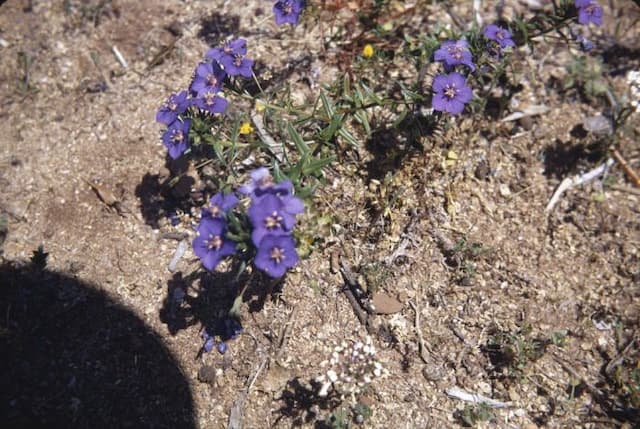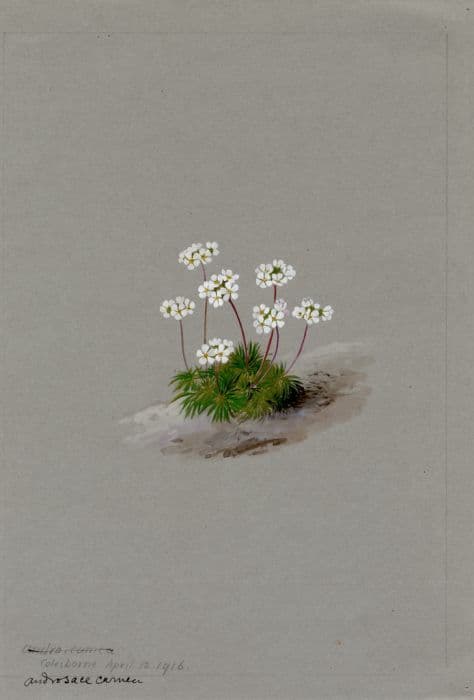Bear's ear auricula Primula auricula 'Larry' (Au/a)

ABOUT
Primula auricula 'Larry', commonly known as Auricula or Bear's Ear, is a cultivated variety of the popular garden flower. This plant typically features a rosette of lush, dark green leaves that are often oval-shaped with a somewhat rounded tip. The foliage can have a slightly leathery texture, and sometimes the leaves may exhibit a powdery bloom that gives them a unique, frosted appearance. The striking feature of Auricula 'Larry' is its flowers. The blooms have a distinct, intricate form, which includes a round or bell-shaped outline. They are characterized by their rich, velvety petals that can come in a range of colors, often in deep and vivid hues. At the center of each flower, there is usually a contrasting, often lighter-colored eye, which adds to the visual interest of the plant. The blooms are held in clusters above the foliage, creating an eye-catching display. The beauty of the Auricula 'Larry' is further enhanced by its patterned petals. The flowers may display various marking types such as stripes, dusting, or edge coloration, which adds to their individuality and ornamental appeal. The overall impression is one of a small but intricate bloom that can catch the eye and add a splash of color to any garden space.
About this plant
 Names
NamesFamily
Primulaceae.
Synonyms
Bear's Ear Auricula, Mountain Cowslip, Bear's Ear Primrose.
Common names
Primula auricula 'Larry'
 Toxicity
ToxicityTo humans
The plant in question is commonly known as Auricula, which is a variety of Primula. Generally, most species of Primula can be considered safe and are not known for being toxic to humans. However, some individuals may experience skin irritation or an allergic reaction due to the plant's sap. If ingested, while not highly toxic, it could potentially cause mild stomach upset. There is no widespread documentation of severe poisonings from consuming any part of this plant in humans.
To pets
Auricula, the common name for Primula auricula 'Larry', is not listed as highly toxic to pets. However, as with humans, some species of Primula may cause mild gastrointestinal upset if ingested by pets. Symptoms can include vomiting or diarrhea. Additionally, the sap of the plant can sometimes cause skin irritation in sensitive pets if they come into contact with it. Serious toxic effects are not commonly reported. If you suspect your pet has ingested a substantial amount of the plant and is showing adverse symptoms, it is best to consult with a veterinarian.
 Characteristics
CharacteristicsLife cycle
Perennials
Foliage type
Evergreen
Color of leaves
Varies
Flower color
Varies
Height
6 inches (15 cm)
Spread
6 inches (15 cm)
Plant type
Herb
Hardiness zones
5
Native area
Europe
Benefits
 General Benefits
General Benefits- Ornamental Value: Primula auricula 'Larry' adds vibrant color and visual interest to gardens with its unique and striking flowers.
- Easy to Grow: This plant is relatively easy to cultivate, appealing to gardeners of all levels of experience.
- Drought Tolerance: Though it prefers moist conditions, it can tolerate periods of dryness better than many other plants, making it suitable for various climates.
- Compact Size: Its small growth habit makes it suitable for rockeries, borders, and containers where space is limited.
- Spring Blooming: It produces flowers in spring, providing early seasonal color when many other plants are not yet in bloom.
- Attracts Pollinators: The flowers can attract bees and butterflies, supporting local ecosystems and benefiting other plants in the area.
 Medical Properties
Medical PropertiesThis plant is not used for medical purposes.
 Air-purifying Qualities
Air-purifying QualitiesThis plant is not specifically known for air purifying qualities.
 Other Uses
Other Uses- The leaves of the auricula can be used as a natural dye, imparting a range of colors from green to brown depending on the mordant used.
- Auricula flowers can be pressed and included in floral art such as bookmarks, greeting cards, or framed botanical art due to their vivid colors and unique shape.
- Primula auricula can serve as a muse for artists and poets, often being featured in watercolor paintings, photographs, and literature due to its striking appearance.
- The auricula is sometimes used as a theme for traditional and contemporary jewelry designs, including brooches, earrings, and pendants.
- Auricula flowers can be crystallized and used as edible decorations for desserts, adding an elegant touch to cakes and pastries.
- In historical times, the auricula was often the centerpiece of "auricula theatres," which are special wooden display cases designed for showcasing these flowers.
- Varieties like the auricula 'Larry' can be used in horticulture and botany education due to their variety of mutations and hybridization possibilities.
- These flowers can be used in sensory gardens, as they offer a range of textures and colors for a tactile and visual experience.
- Primula auricula can play a role in companion planting, potentially benefiting other plants in the garden by attracting pollinators.
- The auricula can be used in potpourri mixes, contributing to the aesthetic aspect, although it's not primarily known for a strong fragrance.
Interesting Facts
 Feng Shui
Feng ShuiThe Primula is not used in Feng Shui practice.
 Zodiac Sign Compitability
Zodiac Sign CompitabilityThe Primula is not used in astrology practice.
 Plant Symbolism
Plant Symbolism- Unique Beauty: The Primula auricula 'Larry', also known as Auricula or Mountain Cowslip, often symbolizes the uniqueness and rare beauty due to its distinctive pattern and coloration.
- Boldness: With its striking appearance, Auriculas are often associated with courage and a willingness to stand out from the crowd, representing boldness.
- Perseverance: Auriculas are hardy plants that can thrive in difficult conditions. This resilience makes them a symbol of perseverance and the endurance to overcome challenges.
- Admiration: The plant is frequently given as a gift to express admiration for someone’s qualities, akin to other flowers that convey appreciation.
- Rarity: Since the Auricula 'Larry' can be rare and is treasured by collectors, it symbolizes something that is sought after or considered a rare find.
 Water
WaterThe common name for Primula auricula 'Larry' is Auricula. To water Auricula adequately, check the topsoil: when the first inch is dry, it's time to water. Generally, this might equate to watering once every 7 to 10 days, but this can vary with environmental conditions. Use room temperature water to gently soak the soil until it begins to run out of the drainage holes, which might be around 16-24 ounces for a standard pot, but this will vary with pot size. Reduce watering in the winter when the plant is dormant.
 Light
LightAuriculas like Primula auricula 'Larry' thrive in bright, indirect light, where they are shielded from the harsh afternoon sun. An ideal spot would be an east-facing window or a shaded part of a south or west-facing window. These conditions provide the gentle morning light that promotes flowering without causing leaf scorch.
 Temperature
TemperatureAuriculas prefer cool to moderate temperatures, thriving in conditions ranging from 50 to 75 degrees Fahrenheit. They can survive brief periods as low as 40 degrees but should be protected from frost. The ideal temperature range for Primula auricula 'Larry' is between 60 and 70 degrees Fahrenheit at daytime, slightly cooler at night.
 Pruning
PruningPrune Auriculas such as Primula auricula 'Larry' to remove dead or faded flowers and leaves, which encourages new growth and maintains a tidy appearance. Pruning is typically done after flowering, which is usually in the spring. Deadheading spent blooms can also promote a second, though less vigorous, flowering period.
 Cleaning
CleaningAs needed
 Soil
SoilAuricula Primrose benefits from a well-draining, loamy soil with a slightly alkaline pH between 6.5 and 7.5. The best soil mix can be created by combining equal parts garden loam, leaf mold or peat, and coarse sand. Ensure the mix is airy to prevent root rot.
 Repotting
RepottingAuricula Primroses should be repotted annually, preferably in the fall. This frequency ensures fresh nutrients and reduces the build-up of harmful pathogens in the soil.
 Humidity & Misting
Humidity & MistingAuricula Primrose thrives in moderate humidity levels. Aim for about 50-60% relative humidity around the plant for optimal growth.
 Suitable locations
Suitable locationsIndoor
Give Auricula Primrose bright light, minimal direct sun.
Outdoor
Choose a shaded spot and shelter from heavy rain.
Hardiness zone
4-8 USDA
 Life cycle
Life cycleThe Primula auricula, commonly known as Auricula or Mountain Cowslip, begins its life cycle as a seed, which germinates in moist, well-draining soil in a cool environment. After germination, seedlings emerge and grow into rosettes of lush green leaves, a basal stage that can last for several weeks to months as the plant matures. The plant enters a vegetative stage where it develops its full foliage and becomes established in its growing location. As it enters the flowering stage, usually in early spring, the Auricula produces tall stalks adorned with clusters of bright, ornamental flowers in a variety of colors, which can attract pollinators such as bees and butterflies. After pollination, these flowers will develop into seed pods, completing the reproductive phase. As the plant matures and if the conditions remain favorable, it will often enter a period of dormancy in the late autumn or winter, only to restart its growth cycle again with the return of favorable conditions in the following spring.
 Propogation
PropogationPropogation time
Late winter-early spring
The Primula auricula, commonly known as Auricula Primrose, has a popular method of propagation through division which is typically done in the late summer after the plant has finished flowering. To divide Auricula Primrose, carefully lift the clump from the ground with a spade, ensuring you keep as many roots intact as possible. Gently tease the clump apart into smaller sections, each with a rosette of leaves and a portion of the root system. These divisions can then be replanted immediately into well-draining soil, spacing them about 6 to 12 inches (15 to 30 centimeters) apart to allow for adequate growth. Ensure the plants are watered in well after planting. This method of vegetative propagation ensures that the new plants are genetically identical to the parent, preserving the unique characteristics of the 'Larry' cultivar.









